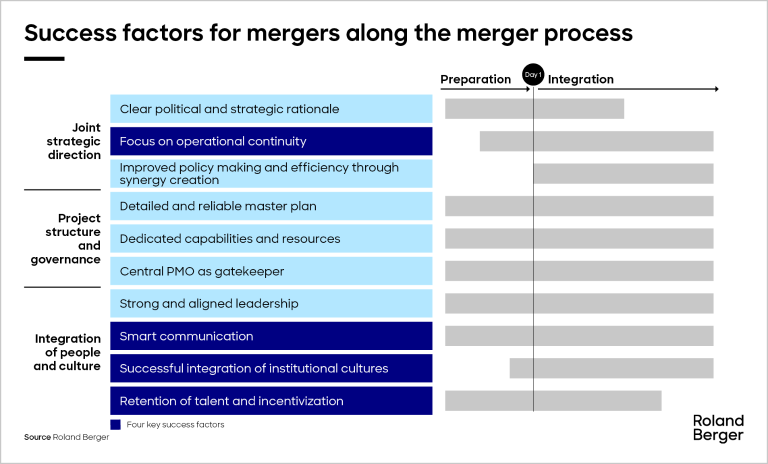Roland Berger works with public, private and non-governmental clients in meeting the major challenges within our society. Contact us now.


Ensuring the success of mergers in the public sector
By Ina Wietheger and Wiebke Stranz
Four key factors to unlock potential and realize synergies
There are many good reasons for previously separate public organizations to join forces and become one, especially in today’s changing and challenging world. Tight government budgets and a growing shortage of skilled labor are only two of the more obvious ones. But whatever the reasons, intricate planning and precise execution will be needed if a potentially beneficial fusion is not to degenerate into a wasted opportunity or, worse, an entity that destroys value.

"A successful merger is one driven by courage, blending clear goals with empathy, a sense of responsibility, and unwavering persistence."
A merger is a merger, right? Wrong!
Our paper specifically examines mergers in the public sector. While there are obviously overlaps with corporate mergers on issues such as streamlining structures, tapping synergies and cutting costs, several important points set public sector mergers apart – and demand suitably adapted approaches.
Benefits and challenges
Pooling everything from infrastructure to expertise and optimizing the allocation of resources are straightforward ways in which public agencies stand to benefit by joining forces. Similarly, organizational improvements can be achieved by adjusting the workforce, minimizing internal interfaces and sharing data platforms to drive more rigorous technology adoption. Ultimately, however, a successful merger will always be one that creates an entity that is better able to serve the public effectively and efficiently.
Four key success factors for mergers in the public sector
The complexity of blending two (or more) established organizations and often proud cultures will always be challenging, not to say daunting in many cases. Roland Berger therefore digs deep into the lessons it has learned from years of accompanying public merger and integration projects throughout Europe and identifies ten factors that regularly lead to success outcomes. We then distill these into four key factors on which the success or failure of every public sector merger will hinge to a large degree.
No two mergers are alike
Each public sector merger is unique and needs to be addressed as such. Besides focusing on the key success factors outlined above, it is therefore also important to plan and carefully coordinate the many proven approaches that account for these differences and ensure successful outcomes.
With this in mind, Roland Berger extends an open invitation to dialogue for anyone (potentially) involved in the complex world of public sector mergers. We look forward to hearing from you!
The first key success factor in a public merger context is staying focused on operational continuity. Whatever changes are taking place at an organizational or technological level, service to the public – in some cases in the interests of national security or emergency service provision – must proceed seamlessly and without interruption. Our new paper explores how this critical goal can be achieved amid the complexities of a merger project.
The second – a factor all too frequently overlooked or belittled – is to get the communication right. Change inevitably brings fears and uncertainties, so leadership needs to keep all stakeholder groups in the loop and make sure two-way dialogue is enabled rather than one-way edicts.
Third, it is vital to merge not just the organizations but the underlying cultures of the units involved. Differences are normal, but must be encouraged to complement each other rather than work against each other and potentially undermine any hoped-for gains from a “merger of equals”.
Lastly, especially at a time when top talent is at a premium, a clear strategy to retain talent and incentivize people is absolutely essential. That said, since success is often measured differently at public administrations, the new paper advocates alternative incentives to the primarily financial rewards that often characterize corporate fusions.
Register now to access the full study, to explore the rationale behind organizational mergers and the criticality of meticulous planning and execution.







